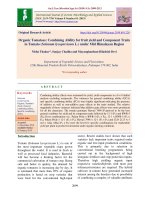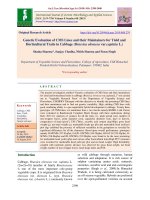Correlation and path coefficient studies for kernel yield and component traits in maize
Bạn đang xem bản rút gọn của tài liệu. Xem và tải ngay bản đầy đủ của tài liệu tại đây (442.5 KB, 7 trang )
Int.J.Curr.Microbiol.App.Sci (2020) 9(8): 168-174
International Journal of Current Microbiology and Applied Sciences
ISSN: 2319-7706 Volume 9 Number 8 (2020)
Journal homepage:
Original Research Article
/>
Correlation and Path Coefficient Studies for Kernel Yield and
Component Traits in Maize
S. Mallikarjuna1*, V. Roja1, I. Sudhir Kumar2 and T. Srinivas1
1
Department of Genetics and Plant Breeding, Agricultural College, Bapatla 522 101,
Guntur District, Andhra Pradesh, India
2
Agricultural Research Station, Peddapuram, East Godavari District, Andhra Pradesh, India
*Corresponding author
ABSTRACT
Keywords
Maize, Correlation,
Path Analysis
Article Info
Accepted:
10 July 2020
Available Online:
10 August 2020
Correlation and path coefficient analysis for kernel yield and yield components was under
taken in 49 maize inbred lines using simple lattice design with two replications during
kharif, 2018 at Agricultural Research Station, Peddapuram, East Godavari district, Andhra
Pradesh in order to understand the relationship between kernel yield and its component
traits. The studies revealed significant and positive association of kernel yield plant -1 with
cob length, cob girth and cob yield plant-1 at both phenotypic and genotypic levels. The
path analysis revealed high positive and direct effect of cob yield plant -1 for kernel yield
plant-1 in addition to strong positive association with kernel yield per plant indicating its
true relationship with kernel yield plant-1.Considering the nature and quantum of trait
associations and their direct and indirect effects, cob yield plant -1 is identified as important
selection criteria for effecting kernel yield improvement in maize.
Therefore, correlation studies are of
considerable importance in any selection
programme as they provide information on
the degree and direction of relationship
between two or more component traits.
Besides this, path coefficient analysis is also
important because it provides an effective
means of estimating the direct and indirect
effects of the independent variables on the
dependent variable and permits a critical
examination of the specific forces acting to
produce a given correlation and measures the
relative importance of each factor. Keeping
these points in view the present investigation
was carried out to estimate the character
Introduction
Maize is one of the most important crop
belonging to the family Poaceae. In India,
maize is grown throughout the year in most of
the states. It is grown for both human as well
as animal consumption. For producing high
yielding genotypes in maize, selection based
on yield alone is not useful because yield is a
complex and polygenic character resulting
from multiplicative interaction of its
component traits. The cumulative effect of
component traits determines yield and plays
an important role in modification of yield as a
whole in magnitude as well as in direction.
168
Int.J.Curr.Microbiol.App.Sci (2020) 9(8): 168-174
association and path coefficients for yield and
its component traits.
direction and significance in general.
However, the phenotypic coefficients were
observed to be of lower magnitude in general,
compared to genotypic coefficients, indicating
the masking effect of environment. The
findings are in agreement with the reports of
Lokeshwar Reddy et al., (2018). The trait, cob
yield plant-1 had recorded positive and
significant association with kernel yield plant1
followed by cob length and cob girth at both
genotypic and phenotypic levels.
Materials and Methods
The present investigation was carried out at
Agricultural Research Station, Peddapuram,
East Godavari district, Andhra Pradesh during
kharif’2018. The experimental material
comprised of 49 elite maize inbred lines. The
genotypes were evaluated using simple lattice
design with two replications and data was
recorded for 14 traits, namely days to 50
percent tasseling, days to 50 percent silking,
anthesis silking interval, days to maturity,
plant height (cm), ear placement height (cm),
cob length (cm), cob girth (cm), number of
kernel rows per cob, number of kernels per
row, cob yield per plant (g), kernel yield per
plant (g), 100 kernel weight (g) and protein
content (%) on five randomly selected plants,
for each genotype, from each entry, in each
replication.
These results are in agreement with the
findings of Bisen et al., (2018). Whereas, the
traits like kernel rows cob-1 and kernels row-1
exhibited significant and positive association
at phenotypic level. These results are in
agreement with the reports of Bikal and
Timsina (2015). Further, the traits, namely,
plant height and ear placement height
recorded significant and positive correlation
coefficients values with kernel yield per plant
at genotypic level. The results are in
conformity with the findings of Lad et al.,
(2018) and Grace et al., (2018). The trait,
anthesis silking interval alone had however,
recorded significant and negative correlation
at genotypic level.
Correlation coefficients were calculated at
genotypic and phenotypic level using the
formulae suggested by Falconer (1964) and
path analysis was carried out as per the
suggestions of Dewey and Lu (1959). The
path coefficients were categorized as high,
moderate and low based on the
recommendations of Lenka and Mishra
(1973). The statistical software used for
analysis of the data is Statistical Analysis
Software (SAS) 9.2 version and Windostat
9.1.
Association analysis among yield contributing
traits, revealed positive and significant
association of days to 50 per cent tasseling
with days to 50 per cent silking, days to
maturity, plant height and ear placement
height; days to 50 per cent silking with days
to maturity, plant height and ear placement
height; days to maturity with plant height and
ear placement height; plant height with ear
placement height, cob length, 100 kernel
weight and cob yield plant-1; cob length with
cob girth and cob yield plant-1; cob girth with
cob yield plant-1and 100 kernel weight; and
kernels row-1 with cob yield plant-1 at both
genotypic level and phenotypic levels. Similar
results were observed earlier by Lad et al.,
(2018).
Results and Discussion
Correlation coefficient
The estimates of genotypic and phenotypic
correlation coefficients for yield and yield
components are presented in Table 1. The
results revealed phenotypic and genotypic
correlation coefficients to be of similar
169
Int.J.Curr.Microbiol.App.Sci (2020) 9(8): 168-174
Table.1 Phenotypic (above the diagonal) and genotypic (below the diagonal) correlations among kernel yield
and its attributing characters in maize (Zea mays L.)
Character
DT
DS
ASI
DM
PH
EPH
CL
CG
KR
KPR
CYP
100 KW
PC
KYP
DT
1.0000
0.9969**
0.0077
0.9135**
0.4206**
0.2415*
0.0830
0.0482
0.0599
0.1349
0.0310
0.0981
-0.2075*
0.0229
DS
0.9997**
1.0000
0.0331
0.9126**
0.4080**
0.2232*
0.0708
0.0342
0.0334
0.1335
0.0198
0.0988
-0.2044*
0.0201
ASI
0.0957
0.0942
1.0000
0.0029
-0.2373*
-0.2696**
-0.0956
-0.0790
-0.1795
0.0405
-0.0109
-0.0200
0.0120
0.0511
DM
0.9685**
0.9609**
-0.0159
1.0000
0.4803**
0.2984*
0.0755
0.0541
0.0774
0.0487
0.0258
0.1801
-0.2828**
0.0149
PH
0.4824**
0.4675**
-0.4465**
0.5590**
1.0000
0.7143**
0.2743**
0.1066
-0.0127
0.1841
0.2555*
0.3305**
-0.1847
0.1944
EPH
0.2832**
0.2639**
-0.5649**
0.3596**
0.8182**
1.0000
0.1772
0.0007
0.0502
0.1062
0.2257*
0.1681
-0.1074
0.1120
CL
0.1424
0.1169
-0.2837**
0.0760
0.4322**
0.3977**
1.0000
0.4687**
-0.0395
0.3595**
0.5218**
-0.0059
0.0399
0.5212**
CG
0.0206
0.0062
-0.0814
0.0031
0.2038*
0.0199
0.3191**
1.0000
0.1557
0.1757
0.6016**
0.2140*
0.0284
0.6082**
KR
0.0513
0.0230
-0.6644**
0.0692
0.1051
0.0138
-0.1295
0.1329
1.0000
-0.0079
0.2525*
-0.1093
-0.1380
0.2167*
KPR
0.2149*
0.2136*
0.1295
0.0662
0.2931**
0.1811
0.2940**
-0.0801
-0.3225**
1.0000
0.4841**
-0.0440
-0.0375
0.4068**
CYP
0.1158
0.0924
-0.3388**
0.1289
0.5946**
0.4086**
0.4734**
0.8437**
0.0863
0.2320*
1.0000
0.1691
-0.0411
0.9308**
100 KW
0.1596
0.1555
0.0949
0.3409**
0.4676**
0.2703**
-0.1265
0.3697**
-0.3151**
-0.1857
0.3734**
1.0000
-0.0345
0.1098
PC
-0.2920**
-0.2961**
0.1605
-0.4514**
-0.3219**
-0.1156
0.0977
0.2112*
-0.4513**
-0.2342*
0.0036
-0.0124
1.0000
0.0291
KYP
0.1069
0.0880
-0.2715**
0.0795
0.4176**
0.2033*
0.4147**
0.8235**
0.0315
0.0550
0.8826**
0.1575
0.1481
1.0000
*
Significant at 5 per cent level ** Significant at 1 per cent level
DT: Days to 50 per cent Tasseling; DS: Days to 50 per cent Silking; ASI: Anthesis Silking Interval; DM: Days to Maturity; PH: Plant Height; EPH: Ear Placement
Height; CL: Cob Length; CG: Cob Girth; KR: Kernel rows cob-1; KPR: Kernels row-1; CYP: Cob Yield Plant-1; 100 KW: 100 kernel Weight; PC: Protein Content; KYP:
Kernel Yield Plant-1
170
Int.J.Curr.Microbiol.App.Sci (2020) 9(8): 168-174
Table.2 Direct (diagonal) and indirect effects (above and below the diagonal) of different traits on
kernel yield per plant in maize (Zea mays L.)
Character
DT
DT
DS
ASI
5.2070
0.0312
G -4.2147
1.1658
0.0003
P -1.1591
0.0307
DS
G -4.2135
5.2086
0.0011
P -1.1555
1.1695
0.4907
ASI
G -0.4032
0.3260
0.0387
P -0.0090
0.0332
5.0047
-0.0052
DM
G -4.0822
1.0673
0.0001
P -1.0588
-2.0330
2.4349
-0.1456
PH
G
0.4771
-0.0079
P -0.4875
1.3743
-0.1842
EPH
G -1.1936
0.2610
-0.0089
P -0.2799
0.6089
-0.0925
CL
G -0.6000
0.0828
-0.0032
P -0.0962
0.0324
-0.0265
CG
G -0.0870
0.0400
-0.0026
P -0.0559
-0.2160
0.1196
-0.2166
KR
G
0.0390
-0.0060
P -0.0694
1.1127
0.0422
KPR
G -0.9059
0.1562
0.0013
P -0.1563
0.4810
-0.1104
CYP
G -0.4882
0.0231
-0.0004
P -0.0359
0.8100
0.0310
100 GW
G -0.6725
0.1156
-0.0007
P -0.1137
-1.5424
0.0523
PC
G 1.2307
0.2405
-0.2390
0.0004
P
P: Phenotypic level
G: Genotypic level
DM
-0.9718
0.0023
-0.9641
0.0023
0.0159
0.0001
-1.0034
0.0025
-0.5609
0.0012
-0.3608
0.0007
-0.0763
0.0002
-0.0031
0.0001
-0.0694
0.0002
-0.0664
0.0001
-0.1294
0.0001
-0.3421
0.0004
0.4529
-0.0007
PH
EPH
CL
CG
0.1258
-0.0586
-0.0029
-0.0156
0.0362
-0.0280
0.0036
0.0027
0.1219
-0.0546
-0.0024
-0.0047
0.0351
-0.0259
0.0031
0.0019
-0.1165
0.1168
0.0058
0.0613
-0.0204
0.0313
-0.0042
-0.0044
0.1458
-0.0744
-0.0016
-0.0024
0.0413
-0.0346
0.0033
0.0030
-0.1692
-0.0088
-0.1537
0.2608
-0.0829
0.0120
0.0060
0.0860
0.2134
-0.0081
-0.0150
-0.2068
0.0614
0.0077
0.0000
-0.1161
0.1127
-0.0822
-0.2406
-0.0205
0.0236
-0.0206
0.0262
0.0436
0.0532
-0.0041
-0.0065
-0.7540
0.0092
-0.0001
0.0204
0.0558
0.0274
-0.0028
0.0026
-0.1002
-0.0011
-0.0058
-0.0017
0.0087
0.0764
-0.0375
-0.0060
0.0604
0.0158
-0.0123
0.0157
0.0098
0.1551
-0.0845
-0.0097
-0.6361
0.0220
-0.0262
0.0228
0.0336
0.1220
-0.0559
0.0026
-0.2787
0.0284
-0.0195
-0.0003
0.0119
-0.0840
0.0239
-0.0020
-0.1592
-0.0159
0.0125
0.0017
0.0016
Residual effect at genotypic level = 0.1247
KR
KPR
CYP
100 GW
PC
-0.0095
-0.1903
0.2434
-0.0747
0.0375
0.0009
-0.0108
0.0292
-0.0070
-0.0132
-0.0043
-0.1892
0.1941
-0.0728
0.0380
0.0005
-0.0106
0.0186
-0.0070
-0.0130
0.1232
-0.1147
-0.7119
-0.0444
-0.0206
-0.0028
-0.0032
-0.0103
0.0014
0.0008
-0.0128
-0.0586
0.2710
-0.1595
0.0580
0.0012
-0.0039
0.0243
-0.0128
-0.0179
-0.0195
-0.2595
1.2495
-0.2188
0.0414
-0.0002
-0.0147
0.2405
-0.0235
-0.0117
-0.0026
-0.1604
0.8586
-0.1265
0.0149
0.0008
-0.0085
0.2124
-0.0120
-0.0068
0.0240
-0.2604
0.9948
0.0592
-0.0126
-0.0006
-0.0287
0.4911
0.0004
0.0025
-0.0246
0.0709
1.7731
-0.1730
-0.0271
0.0024
-0.0140
0.5662
-0.0152
0.0018
0.2856
0.1814
0.1475
0.0580
-0.1854
0.0006
0.2376
0.0078
-0.0087
0.0154
0.0598
0.4876
0.0869
0.0301
-0.8855
-0.0001
0.4556
0.0031
-0.0024
-0.0798
-0.0160
-0.2055
-0.1747
-0.0005
2.1015
0.0039
-0.0386
-0.0120
-0.0026
0.9411
0.0584
0.1644
0.7847
0.0016
-0.4679
-0.0017
0.0035
0.1591
-0.0022
-0.0713
0.0837
0.2074
0.0075
0.0058
-0.1285
-0.0021
0.0030
-0.0387
0.0025
0.0634
Residual effect at phenotypic level =0.3164
GYP
0.1069
0.0229
0.0880
0.0201
-0.2715**
0.0511
0.0795
0.0149
0.4176**
0.1944
0.2033*
0.1120
0.4147**
0.5212**
0.8235**
0.6082**
0.0315
0.2167*
0.0550
0.4068**
0.8826**
0.9308**
0.1575
0.1098
0.1481
0.0291
DT: Days to 50% tasseling; DS: Days to 50% silking; ASI: Anthesis silking interval; DM: Days to maturity; PH: Plant height; EPH: Ear placement height; CL: Cob Length;
CG: Cob girth; KR: Kernel rows cob-1; KPR: Number of kernels row-1; CYP: Cob yield plant-1; 100 GW: 100 kernel weight; PC: Protein content; KYP: Grain yield plant-1
171
Int.J.Curr.Microbiol.App.Sci (2020) 9(8): 168-174
Fig.1 Genotypic path diagram showing direct and indirect effects of yield components
on kernel yield plant-1 in maize (Zea mays L.)
Fig.2 Phenotypic path diagram showing direct and indirect effects of yield components on kernel
yield plant-1 in maize (Zea mays L.)
172
Int.J.Curr.Microbiol.App.Sci (2020) 9(8): 168-174
The analysis also revealed negatively
significant inter-character association of
protein content with days to 50 percent
tasseling, days to 50 percent silking and days
to maturity. These results are in consonance
with the findings of Sukumar et al., (2018)
and Lad et al., (2018). Association of anthesis
silking interval with plant height and ear
placement height was also noticed to be
significant and negative at both genotypic and
phenotypic levels, indicating the need for
balanced
selection,
while
effecting
improvement for these traits.
2018. However, days to 50 percent silking
recorded non-significant positive direct effect
(Grace et al., 2018). Further, the traits like
cob yield per plant, cob girth and kernel rows
cob-1 at phenotypic level and anthesis silking
interval and plant height at genotypic level
had exhibited significant positive direct
effects on kernel yield per plant. The results
of plant height are in agreement with the
findings of Grace et al., (2018) and those of
anthesis silking interval with reports of
Kumar et al., (2017).
The traits cob length, (pp =0.0436) and cob
girth (pp =0.0558) exhibited low direct effects
but strong correlation with grain yield due to
the high indirect effect via cob yield plant-1.
Similar results were reported by Lakshmi et
al., (2018) and Sukumar et al., (2018). Futher,
significant negative direct effect was
exhibited by the trait number of kernels row-1
(pp = -0.0798 and pg = -0.8855) for kernel
yield plant-1 via indirect effect through 100
kernel weight (pp = 0.003 and pg = 0.2074).
Similar findings were reported earlier by
Nirmal et al., (2018).
The characters, namely cob length, cob girth
and cob yield plant-1 had exhibited significant
and positive correlation at both genotypic and
phenotypic level with kernel yield and hence
may be considered as important selection
criteria for kernel yield improvement in
maize.
Path analysis
Estimates of direct and indirect effects of
individual characters towards kernel yield are
presented in Table 2 and Figures 1 & 2. A
perusal of the results revealed residual effect
of 0.1247 at genotypic level and 0.3164
percent at phenotypic level, indicating that
87.53 percent and 68.36 percent of the
variability in the dependent variable, kernel
yield plant -1 was explained by the
independent variable or traits studied in the
present investigation at genotypic and
phenotypic levels, respectively.
The results of path coefficient analysis thus
revealed the importance of cob yield per plant
for genetic improvement of the kernel yield
plant-1.
In conclusion the studies on character
association and path coefficient for kernel
yield per plant and yield component
characters revealed the importance of cob
yield per plant-1 in improvement of kernel
yield plant-1. Hence, cob yield per plant-1 is
identified as an effective selection crioteria
for kernel yield improvement in maize.
The path coefficient analysis revealed high
positive direct effect of cob yield yield plant1
for kernel yield at both genotypic and
phenotypic levels coupled with positive and
significant association of the trait with kernel
yield per plant indicating its importance as
effective selection criteria for kernel yield
improvement in maize. The results are in
agreement with the findings of Gazal et al.,
References
Bikal, G and Timsina, D. 2015. Analysis of yield
and yield attributing traits of maize
genotypes in Chitwan, Nepal. World
Journal of Agricultural Research. 3 (5):
173
Int.J.Curr.Microbiol.App.Sci (2020) 9(8): 168-174
153-162.
Bisen, N., Rahangdale, C.P and Sahu, R.P. 2018.
Genetic variability and correlation studies
of yield and yield component in maize
hybrids (Zea mays l.) under kymore plateau
and satpura hill region of madhya
pradesh. International
Journal
of
Agriculture,
Environment
and
Biotechnology. 11 (1): 71-77.
Dewey, D and Lu, K.H. 1959. A correlation and
path coefficient analysis of components of
crested wheat grass seed production.
Agronomy Journal. 51: 515-518.
Falconer, D.S. 1964. An Introduction to
Quantitative Genetics. Oliver and Boyd
Publishing Co. Pvt. Ltd., Edinburgh. 312324.
Gazal, A., Dar, Z.A., Lone, A.A., Yousuf, N and
Gulzar, S. 2018. Studies on maize yield
under drought using correlation and path
coefficient analysis. International Journal
of Current Microbiology and Applied
Science. 7 (1): 516-521.
Grace, B., Marker, S and Rajasekhar, D. 2018.
Assessment of quantitative genetic
variability and character association in
maize (Zea mays L.). Journal of
Pharmacognosy and Phytochemistry. 7 (1):
2813-2816.
Kumar, R., Dubey, R.B., Ameta, K.D., Kunwar,
R., Verma, R and Bisen, P. 2017.
Correlation and path coefficient analysis
for yield contributing and quality traits in
quality protein maize (Zea mays
L.). International Journal of Current
Microbiology and Applied Sciences. 6 (10):
2139-2146.
Lad, D.B., Borle, U.M and Dhumal, N.U. 2018.
Studies on genetic variability, association
of characters and path analysis in maize
(Zea mays L.) inbreds. International
Journal of Pure & Applied Bioscience. 6
(4): 241-245.
Lakshmi, M.S., Jagadev, P.N., Das, S., Lenka, D.,
Swain, D and Tripathy, S.K. 2018. Genetic
variability and association analysis of
maize hybrids under excessive soil
moisture condition. International Journal
of Current Microbiology and Applied
Science. 7 (9): 2935-2941.
Lenka, D and Mishra, B. 1973. Path coefficient
analysis of yield in rice varieties. Indian
Journal of Agricultural Sciences. 43:376379.
Lokeshwar Reddy, A., Srinivas, T., Prasanna
Rajesh, A and Uma maheswari P. 2018.
Genetic variability and association anlysis
for yield and yield component traits in
groundnut. Green farming. 9(4). 586-590.
Nirmal, R.R., Renuka, D.C.P and Gokulakrishnan,
J. 2018. Indirect selection for various yield
attributing characters of maize hybrids
across environments using correlation and
path analysis. Journal of Pharmacognosy
and Phytochemistry. 7 (5): 1810-1812.
Sukumar, K., Hemalatha, V., Reddy, N.V and
Reddy, S.N. 2018. Correlation and path
analysis studies for yield and quality traits
in quality protein maize (Zea mays L.).
International
Journal
of
Current
Microbiology and Applied Sciences. 7 (4):
3846-3854.
How to cite this article:
Mallikarjuna, S., V. Roja, I. Sudhir Kumar and Srinivas, T. 2020. Correlation and Path
Coefficient Studies for Kernel Yield and Component Traits in Maize.
Int.J.Curr.Microbiol.App.Sci. 9(08): 168-174. doi: />
174
![Heterosis studies for seed yield and earliness in intra-specific hybrids of ricebean [Vigna umbellata (Thunb.) ohwi and ohashi] an under utilized pulse](https://media.store123doc.com/images/document/2020_01/09/medium_pxu1578554402.jpg)
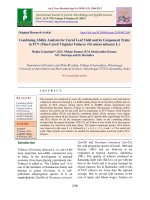
![Genetic variability studies in F2 segregating populations for yield and its component traits in Okra [Abelmoschu sesculentus (L.)Moench]](https://media.store123doc.com/images/document/2020_01/13/medium_nxs1578931693.jpg)
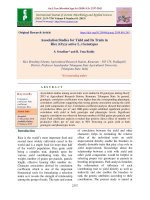
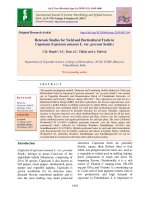
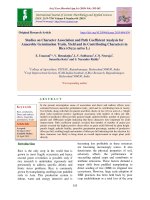
![Correlation and path coefficient analysis of fruits yield and yield attributes in okra [Abelmoschus esculentus (L.) Moench]](https://media.store123doc.com/images/document/2020_01/14/medium_ckb1578982226.jpg)
